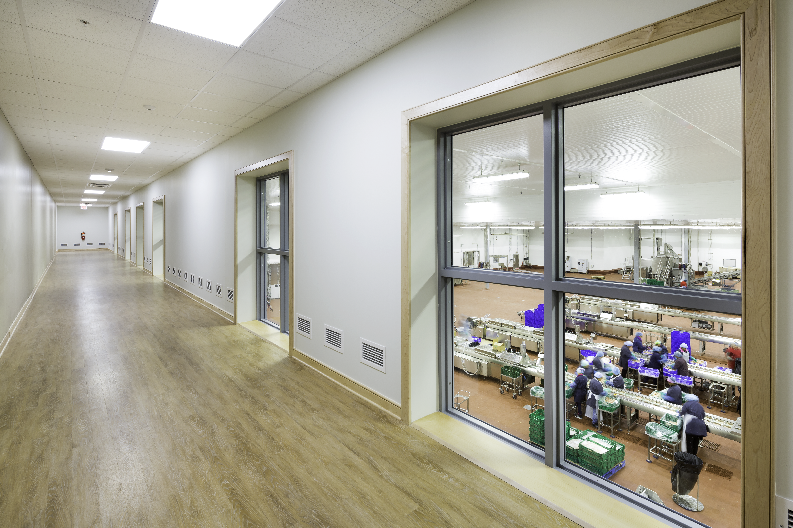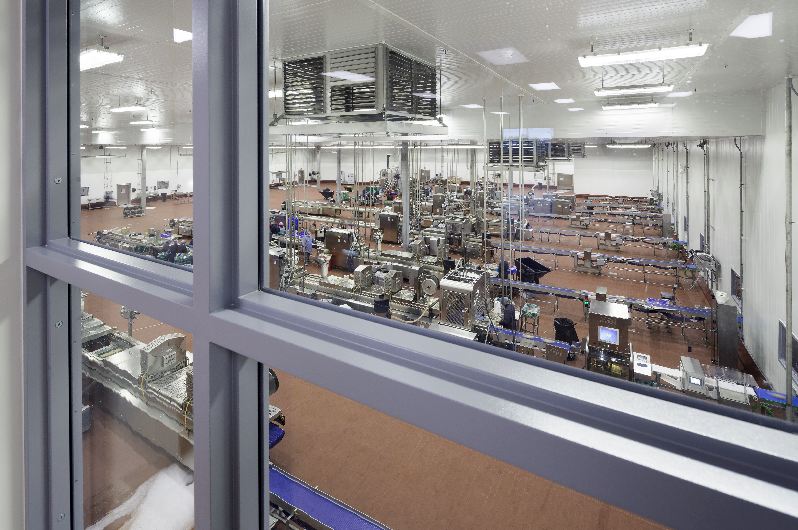Food plant tours can serve as a valuable sales tool for your company. An observation deck, or viewing gallery, is a sanitary design solution that allows you to roll out the welcome mat to visitors. This moderate, added cost solution can be ground level or elevated, offering a behind-the-scenes look at your plant’s critical processes or packaging. Let’s review design best practices in addition to three benefits these structures can offer your food plant.
1. Design flexibility
Observation decks can be designed many different ways, depending on:
- Available building area
- Clear height
- If adding to an existing facility or incorporating into a new plant design
An observation corridor can also be elaborate, created as series of tunnels or hallways through your food plant where guests can look at your processes through viewing ports or windows. This model offers the least potential for contamination possible.

Photo credit: Robert Pepple
Stellar design and built a second-floor viewing corridor for Bell & Evan’s newest facility in Fredericksburg, Pennsylvania. The hallways along the processing area are lined with windows. These viewing corridors are a way to welcome people from the community to see the processes themselves without compromising sanitation.
The structure can also take a simpler form, designed as a catwalk suspended from the ceiling to allow viewers to observe processes from above. This is a relatively low-cost solution that still achieves the same benefits of a more complex observation corridor.
You can determine the best observation-deck design for your food plant by calculating the average size of your plant tours. If your plant tours are larger, opt for a more complex design that can handle more capacity. If your plant tours are smaller, a catwalk should suffice.
2. Increased food safety
When guests enter your food processing facility, the risk for contamination enters with them.
Without an observation area, guests must dress in sanitary gear for tours and follow stringent sanitary precautions: a time-consuming process subject to user error. However because a viewing gallery isolates pedestrians and tour members, you can eliminate such food safety risks.
Maximize food safety benefits by placing observation deck entrances and exits in administrative spaces, away from the processing floor.
For example, when Stellar designed and built a viewing platform for a meat plant, we placed the entrance in the food plant’s offices so guests never have to walk through the processing facility.
3. Controlled food plant viewing
Each and every part of your facility may not be best suited for the public eye. An observation deck or viewing gallery gives you control over what your guests see (and don’t see) during their food plant visits.
Determine your tour goals.
Is it to show off a specific process, or pull back the curtain on your entire food plant? Then, strategically install windows/ visibility to serve your needs.
For example:
- Consider omitting areas that don’t offer visitors benefit from seeing, such as your freezing stage.
- If you have a beverage facility (where most work is hidden within pipes), position your observation deck above your bottling operation.
- If you have a bakery plant, you can show off all of your processes—from mixing to packaging—with long viewing galleries.
- If your tours are more sales-oriented, consider installing a viewing gallery in your test kitchen so guests can learn about new product opportunities.
The meat plant Stellar worked with wanted guests to see the entire processing line without walking through the plant. We designed multiple windows along the second-floor viewing corridor so visitors can see multiple processing areas, including coolers, ovens and blast chillers. Guests have a bird’s eye view while staying behind glass, eliminating the need to gown up.
Answer these questions to drive your own observation deck design and construction:
- Who will be visiting your facility? Customers? Field trips? Sales- or learning-motivated groups?
- Why are they visiting? To learn about your product? Your processes? Your technology?
Another added benefit of a viewing gallery is a more pleasant experience for visitors. Often, large group tours are muffled by loud machines on the floor. But because viewing galleries are isolated, it provides a much quieter environment and tour experience, better suited for conversation.
An added observation deck offers all the benefits of traditional tours, while giving you more control over what visitors see and decreasing sanitation risks. Follow the above best practices to determine which viewing structure is right for your food plant’s needs.
To learn more about the viewing gallery in the Bell & Evans plant, visit their product page on our website.
Editor’s Note: This post was originally published in November 2014 and has been updated to provide more relevant information.



